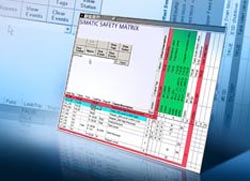Software tool for configuring safety applications in the process industry

Certified up to safety level 3 by the German TÜV Technical Inspectorate, the software from the Siemens Industry Automation Division now features configurable user authorization.
The software also supports the Automation Licence Manager and the import/export assistant of the Simatic PCS 7 process control system. Simatic Safety Matrix is especially suitable for processes with defined requirements or events that necessitate special safety responses. In addition, it can be used for describing and documenting safety functions.
Simatic Safety Matrix is based on the so-called cause-and-effect method, a tabular cause-and-effect logic with which users can easily link process events logically to process reactions without any special programming skills or knowledge. The table automatically generates safety-oriented CFCs (Continuous Function Charts) for the Simatic S7 400FH controllers and also creates documents.
Changes in the matrix then automatically produce new program codes and documentation. Also integrated in the software are matrix reports, such as reports for version management, documentation and program updating. The Safety Matrix Viewer makes it possible to visualize the matrix on any PCS 7 Operator Station.
Media Contact
More Information:
http://www.siemens.com/process-safetyAll latest news from the category: Machine Engineering
Machine engineering is one of Germany’s key industries. The importance of this segment has led to the creation of new university degree programs in fields such as production and logistics, process engineering, vehicle/automotive engineering, production engineering and aerospace engineering among others.
innovations-report offers informative reports and articles covering technologies such as automation, motion, power train, energy, conveyor, plastics, lightweight construction, logistics/warehousing, measurement systems, machine tools and control engineering.
Newest articles

First-of-its-kind study uses remote sensing to monitor plastic debris in rivers and lakes
Remote sensing creates a cost-effective solution to monitoring plastic pollution. A first-of-its-kind study from researchers at the University of Minnesota Twin Cities shows how remote sensing can help monitor and…

Laser-based artificial neuron mimics nerve cell functions at lightning speed
With a processing speed a billion times faster than nature, chip-based laser neuron could help advance AI tasks such as pattern recognition and sequence prediction. Researchers have developed a laser-based…

Optimising the processing of plastic waste
Just one look in the yellow bin reveals a colourful jumble of different types of plastic. However, the purer and more uniform plastic waste is, the easier it is to…



